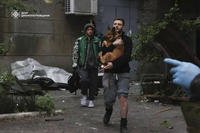Two nearly back-to-back Red Flag exercises at Nellis Air Force Base, Nevada, in recent months have helped prepare airmen taking part in the drills for warfighting scenarios across the globe.
But as the Air Force continues to talk about the next high-end fight with a near-peer adversary, its most advanced fighters, the F-22 Raptor and F-35 Joint Strike Fighter, did not train together in either exercise.
Red Flag, established in 1975 at the end of the Vietnam War, is an integrated, multi-force training exercise within a simulated combat environment. There are three planned this year.
"We brought a notional force of F-35s into the [second] exercise, and it was really more about their sensors than it was about their stealth," said Col. Michael Mathes, commander of the 414th Combat Training Squadron. Military.com spoke with Mathes on March 23, the day Red Flag 18-2 concluded.
Related content:
- Inside the Air Force's Plan to Buy the Dogfight Training of Tomorrow
- Future Battlespace Emerges as F-35 Variants, F-22 Train Together
- Air Force Sees Unique Challenges in Deploying Stealth Fighters
F-22 Raptors participated in Red Flag 18-1 in January but, due to scheduling conflicts, weren't available for Red Flag 18-2, he said.
Even under the umbrella of tactical operations, the focus for each exercise varies, Mathes explained, adding there wasn't much concern that the Defense Department's mightiest fifth-generation fighters weren't flying side-by-side.
The F-35s practiced what Mathes called "a high-density, low threat" environment for Red Flag 18-2. The term could be applied to fighting forces in the Middle East or North Korea -- any adversary with more of a numbers advantage than a technology advantage.
"We don't do a linked campaign here in terms of a week of progressive scenario. We do a single-day operation, and then we change people out so they can get more repetitions and get some more missions" to achieve a larger "battle rhythm" sequence, he said.
"You have to have a building block approach … so that everyone's well prepared to integrate when they all come together," Mathes said. "Coordinating the forces, sharing the information, empowering tactical leadership were really our big challenges to enable our technology."
Red Flag has pilots gearing up for more than just the ability to strike, he said.
Both of this year's completed exercises saw a mix of F/A-18 Hornets, F-15 Eagles, F-16 Fighting Falcons, B-1B Lancers and A-10 Thunderbolt IIs, Mathes said.
Red Flag typically has a joint variation of attack, fighter and bomber aircraft, alongside reconnaissance aircraft such as MQ-9 Reapers, RQ-4 Global Hawks and the U-2 Dragon Lady; electronic warfare aircraft such as EC-130 Compass Calls; airlift such as C-130 Hercules or C-17 Globemaster IIIs; search-and-rescue aircraft such as HH-60 Pave Hawks and HC-130 Kings; refueling aircraft like KC-130s and KC-10 Extenders; and command-and-control aircraft such as the E-3 Sentry AWACS.
Additionally, "red air threats" were simulated by contractors flying F-16s and Douglas A-4 Skyhawks, Mathes said.
When asked how space and cyber threats are incorporated, he said the drill has been rooted in practicing threats from everywhere and anywhere.
For example, jamming is not a new addition to Red Flag, though there were news reports in January warning commercial pilots that the Air Force's jamming signals could affect aircraft from Oregon to New Mexico.
"I saw the GPS jamming issue get picked up by second and third reporting … but this is not the
first time we've done GPS jamming," Mathes said. "It was definitely not the focus or something new or special."
Red Flag 18-1 took place between Jan. 26 and Feb. 16. During the exercises, Mathes was quoted as saying it was the largest Red Flag to date.
"We called it the largest flag ever, but that was only by numbers of people. But it was pretty average on numbers of airplanes," he said without disclosing official numbers. That exercise was about integration with partners and allies -- the U.S., United Kingdom and Australia -- and debriefing their training runs quicker and more efficiently.
The goal was to practice those "new guy type of skills, at the same time we're attempting to build tactical leadership -- mission and package commanders, and flight and team lead," Mathes said.
The 18-2 war drill, by comparison, "had a little bit more of the fighter types," he said. The exercise ran from March 9 to March 23, and incorporated "a little less [intelligence, surveillance and reconnaissance] and bomb types."
The exercise was a joint service effort, Mathes said.
"We balanced more toward training efficiency to get more repetitions … or trips across the range if you will," all while keeping in mind contested environments, he said.
"We do air-to-air, and we do surface-to-air defense suppression, and those are enablers along with command and control, and ISR, [which] are enablers of kinetic and non-kinetic strike ops," Mathes said.
This is about "focusing the force by bringing them [all] together. And it was really about our continued emphasis on readiness," he said.
Red Flag 18-3 is scheduled to begin July 13.
-- Oriana Pawlyk can be reached at oriana.pawlyk@military.com. Follow her on Twitter at @Oriana0214.










